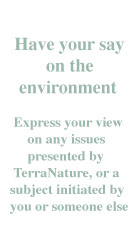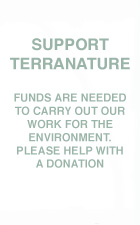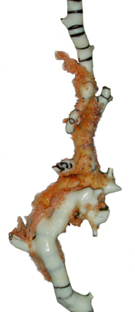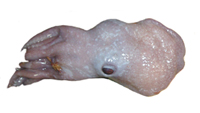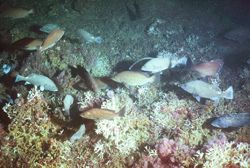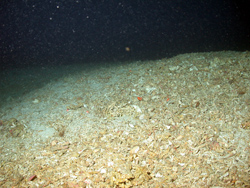|
|
|||||||||||||||||||||||||||||||||||||||||||||||||||||||||||||||||||
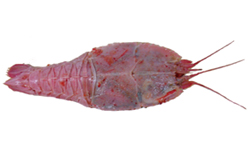 All images are of bycatch from bottom trawling nets, photographed by onboard observers on New Zealand vessels fishing on the high seas in 2004 and 2005. Most of the wide variety of marine animals found in bottom trawling nets are new to science and have not been named.All images Crown Copyright © Ministry of Fisheries, by permission of the Ministry
|
New Zealand's waning position on a UN high seas moratoriumThe New Zealand bottom trawling fleet of 25 to 30 vessels is one of the world's largest operating on the high seas. The NZ government needs to address worldwide bottom trawling by New Zealand vessels that fish in distant locations such as the Indian Ocean, beyond the area of the proposed South Pacific RFMO. Exactly what New Zealand's position is on high seas bottom trawling is anybody's guess. It appears to be convoluted around "ifs" and "buts" the Fisheries Minister relates to the direction a UN agreement may take. Statements from the Minister clearly indicate that the country is not committed, and is not acting to help cause a specific UN resolution. In his press release of 14 February 2006, Jim Anderton said New Zealand would support a global moratorium on high seas bottom trawling, in principle, if such a proposal had sufficient support from States to be a practical and enforceable option. This is a suggestion from the Fisheries Minister that UN controls may be ineffective. World treaties and agreements between nations are consistently violated, but this should not be a reason for not establishing an agreement. New Zealand enthusiastically supports and honours an International Whaling Commission (IWC) moratorium, despite commercial whaling by three countries. New Zealand was a leading nation in establishing a worldwide ban on drift net fishing, without the same concern for enforcement. That was easier when New Zealand did not have a drift net fleet. Mr Anderton also stated in the same press release "In areas where no RFMO exists or is not under negotiation we support a moratorium. However, we need to recognise that without international cooperation such a moratorium will be difficult to enforce". In this case, if negotiations were occurring in the South Pacific RFMO, would New Zealand be hoping to buy more time for its' bottom trawling fleet? Agreement between nations has to be unanimous so all it has to do is not agree to a ban. Chile which is one of the leading nations in forming the RFMO, has stated "taking into account the lack of regulations on the high seas ... States must be encouraged to refrain from authorizing their nationals to conduct fishing activities using destructive practices, including bottom trawling". Chile will be looking to restrict New Zealand bottom trawling, so there is disagreement within the proposed RFMO before it gets underway. It is very apparent that the Minister of Fisheries does not want to impose a moratorium that would reduce the country's seafood exports of $1.2 billion. In addition to trying to avoid the loss of exports, New Zealand has not initiated a restriction in its own waters, or on its own fleet because it does not want other bottom trawling nations to have an unfair advantage. The United Nations provides an opportunity for New Zealand to support a global moratorium on all high seas, and in all RFMOs, that is equally restrictive on all bottom trawling nations. Mr Anderton has also said "... if we cannot get agreement on an RFMO for the South Pacific in the near future, or anywhere else on the high seas for that matter, then we support a moratorium on bottom trawling until sensitive areas can be identified and permanently protected ... " But the Minister stated that it will only support a moratorium if it is enforceable. Instead of taking the wishy-washy back-seat position of waiting for a UN resolution and the commitment of all countries, New Zealand must act immediately according to the need, which the Minister of Fisheries has recognised as urgent. In order to attract the attention of other countries and address the UN General Assembly with credibility, the New Zealand government needs to stop all New Zealand fishing vessels from bottom trawling immediately. |
|
Support for a moratorium from one of the world's largest bottom trawling nations such as New Zealand would have considerable influence at the UN. It is a necessary crucial first step in establishing equal conditions for bottom trawling fisheries worldwide. |
|
|
There is a historical opportunity for New Zealand act with vigor and importance, to lead other bottom trawling countries by example, and to work with the many countries that have already expressed the need for a global moratorium.
The risk to all of New Zealand's primary exports, that are marketed to the world with the "clean and green" label, is enormous, if the country does nothing to stop bottom trawling, and a UN moratorium becomes effective. Credibility in foreign markets as a primary producing country using sustainable practices, which has already been damaged, will be destroyed. New Zealand came under intense criticism for damage caused by bottom trawling in the high seas at the June 2004 meeting of the United Nations Informal Consultation on the Law of the Sea (UNICPLOS). As one of 11 countries with bottom trawling fleets, New Zealand is gaining the same disrepute Japan has obtained as one of 3 countries violating the IWC moratorium on commercial whaling. New Zealand is a leading advocate in opposing whaling. At the FishOps 2006 Workshop, Mr Anderton said "New Zealand has a good story to tell on our environmental management. New Zealand's fisheries management system is acknowledged internationally as one of the few successful quota management systems". The Fisheries Minister says the goal is to at least double the value from commercial fisheries over the next 10 years. He explained that this will be achieved without an increase in the quantity of wild fish caught, by attaining environmental certification to increase the market value. This plan seems to be ironically flawed. Consumers just might not accept a New Zealand eco-label (if it can be obtained) if the country allows destructive fishing practices, and if it earns a reputation as one of a few bottom trawling nations that held out at the United Nations to prevent a global moratorium. Back in 2004 New Zealand talked about its cooperation with Australia to establish regional management to control fishing, and identify areas for protection in the Tasman Sea. Discussions with Australia had actually been going on for a decade at that time. So the talk continues, and there are no agreements. |
|
 |
|










 NZ government’s stance on bottom trawling in international waters is weak and
ineffective .....TAKE ACTION
NZ government’s stance on bottom trawling in international waters is weak and
ineffective .....TAKE ACTION